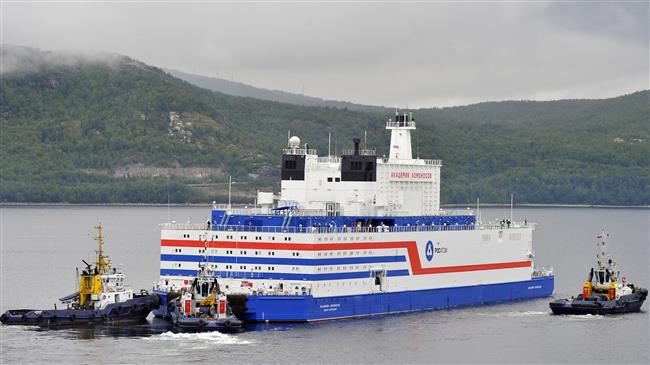Russia launches world's first nuclear power plant in Arctic
Russia has reportedly launched the world’s first floating nuclear power plant, hauling it in an epic 6,000-kilometer journey to a remote Siberian town near the US state of Alaska.
The vessel Akademik Lomonosov left its dock on Friday, heading to the arctic town of Pevek in northeastern Siberia, loaded with nuclear fuel on its two 35-megawatt reactor systems.
The ship, named after Russian polymath, scientist and writer Mikhail Lomonsov, has a crew of 69 and travels at a speed of 3.5 to 4.5 knots.
According to Russia's Rosatom state nuclear energy corporation, the 21,000-ton barge will replace a coal-burning power plant and an ageing land-based nuclear plant.
It will dock at the port in Pevek nearly 90 kilometers from Alaska, supplying 5,000 people in the area with electricity.
Rosatom has described the huge vessel as a "pilot project" with plans for its extensive development and use of similar designs.
The floating reactor is part of a larger scheme to provide energy to remote regions within Russia as well as the rest of the world, the agency says.
Vessels such as the Akademik Lomonosov, with an overall 40-year life cycle that may be extended to 50 years, can be used to power desalination plants for island countries with shortage of fresh water, the agency said.
According to the company, since many remote areas rely on coal-burning plants, portable nuclear plants will help reduce emissions of carbon dioxide, a greenhouse gas that contributes to climate change.
The journey of the Akademik Lomonosov is expected to last between four and six weeks, depending on the weather conditions and the amount of ice on the way.
The facility is due to become operational the end of the year, mainly serving the region's oil platforms as Russia develops the exploitation of hydrocarbons in the Arctic.
The launch of the floating reactor is part of a wider ambition of Russian President Vladimir Putin to develop the Northern Arctic region.
The objective has become more practical in recent years amid global warming and a growing emergence of melting ice caps, making some Arctic areas more accessible.
The development comes as Russia, the US and several other nations have long used nuclear reactors to power sea vessels, including ice breakers and submarines.
The Akademik Lomonosov, however, is set to be the only floating nuclear power plant of its kind when it goes online.
Scientists in China and researchers at the US-based Massachusetts Institute of Technology (MIT) are also working on sea-based nuclear power plants, and France has explored the possibility.
Greenpeace and other environmental groups, however, have warned about the possible dangers of the project, dubbing it a potential "Chernobyl on ice" and a "nuclear Titanic."
The Russian nuclear energy agency emphasized that the risks will be minimized, with spent fuel taken to special storage facilities in mainland Russia.
The floating reactor, it said, is a simpler alternative to building a conventional plant on ground that is frozen all year round, making clear its aim of selling such reactors abroad.

China warns Ukraine over 'irresponsible' claim of Chinese soldiers in war

World growing tired of endless threats against Iran: Russia

Russia’s State Duma approves 20-year strategic partnership treaty with Iran
How Bernie Sanders condemns genocide in Gaza without actually condemning it
VIDEO | Iran-US nuclear talks, repercussions of opposition to Gaza war in Hebrew media
VIDEO | ‘Inhumane, Illegal’: US arrests Palestinian student activist at citizenship ceremony
More Israeli soldiers call for end to Gaza war, immediate negotiations over captives
VIDEO | Zionist control at Columbia University
VIDEO | Zionists and pornography
Iranian diplomat says ‘excessive unilateralism’ renders UN ineffectual against certain states
US conducts new airstrikes on Yemen’s Ma’rib, al-Jawf provinces













 This makes it easy to access the Press TV website
This makes it easy to access the Press TV website